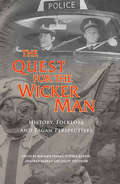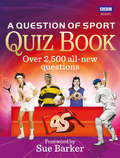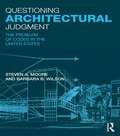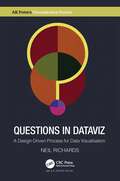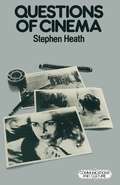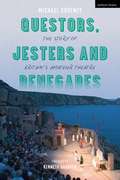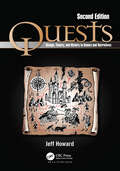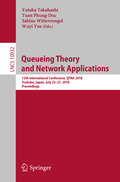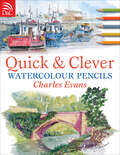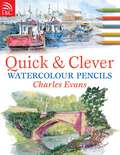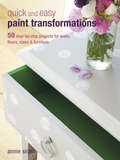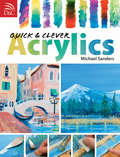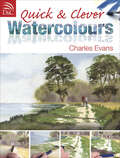- Table View
- List View
Quentin Tarantino's Inglourious Basterds: A Manipulation of Metacinema
by Robert Von DassanowskyThis provocative and unique anthology analyzes Quentin Tarantino's controversial Inglourious Basterds in the contexts of cinema, cultural, gender, and historical studies. The film and its ideology is dissected by a range of scholars and writers who take on the director's manipulation of metacinema, Nazisploitation, ethnic stereotyping, gender roles, allohistoricism, geopolitics, philosophy, language, and memory. In this collection, the eroticism of the club-swinging and avenging "Bear Jew," the dashed heroism of the "role-playing" French and German females, the patriotic fools and pawns, the amoral yokel, Lieutenant Aldo Raine, and the cosmopolitan, but psychopathic Colonel Landa, are understood for their true functions in what has become an iconoclastic pop-culture phenomenon and one of the classics of early twenty-first century American cinema. Additionally, the book examines the use of "foreign" languages (subverting English and image), the allegory of Austria's identity in the war, and the particularly French and German cinematic influences, such as R. W. Fassbinder's realignment of the German woman's film and the iconic image of the German film star in Inglourious Basterds.
Quentin Tarantino's Inglourious Basterds: A Manipulation of Metacinema
by Robert Von DassanowskyThis provocative and unique anthology analyzes Quentin Tarantino's controversial Inglourious Basterds in the contexts of cinema, cultural, gender, and historical studies. The film and its ideology is dissected by a range of scholars and writers who take on the director's manipulation of metacinema, Nazisploitation, ethnic stereotyping, gender roles, allohistoricism, geopolitics, philosophy, language, and memory. In this collection, the eroticism of the club-swinging and avenging "Bear Jew," the dashed heroism of the "role-playing" French and German females, the patriotic fools and pawns, the amoral yokel, Lieutenant Aldo Raine, and the cosmopolitan, but psychopathic Colonel Landa, are understood for their true functions in what has become an iconoclastic pop-culture phenomenon and one of the classics of early twenty-first century American cinema. Additionally, the book examines the use of "foreign" languages (subverting English and image), the allegory of Austria's identity in the war, and the particularly French and German cinematic influences, such as R. W. Fassbinder's realignment of the German woman's film and the iconic image of the German film star in Inglourious Basterds.
The Quest for Charles Rennie Mackintosh (The\quest For Ser. #0)
by John CairneyLike Charles Rennie Mackintosh, John Cairney began his career at the age of 15 at the Glasgow School of Art. He tells of the working life of Charles Rennie Mackintosh as well as the beautiful love story which tragically ended with Mackintosh's sudden death at the age of 60. His wife and co-artist, Margaret Macdonald died three years later.
The Quest for God in the Work of Borges (Continuum Literary Studies)
by Annette U. FlynnThis book argues that the quest for God, though largely unheeded by the critical canon, was a major and enduring preoccupation for Borges. This is shown through careful analysis both of his essays, with their emphasis on his philosophical-theological explorations, and of the narrative articulations which are his stories. It is in the poetry of his middle and closing years, however, that Borges' search is most manifest, as it is no longer obscured. Spanning different periods of his life, and different literary genres, Borges' work attests to a maturing and evolving quest. The book reveals Borges' engagement as an active and evolving process and its chronological structure allows the reader to trace his thought over time. Flynn shows that the spiritual component in Borges' writing drives key texts from the 1920s to the 1980s. Offering an interpretation that unlocks a fuller significance of his work, she shows how Borges' reflections on time and identity are symptomatic of a deeper, spiritual searching which can only be answered by a Divine Absolute.
The Quest for God in the Work of Borges (Continuum Literary Studies #203)
by Annette U. FlynnThis book argues that the quest for God, though largely unheeded by the critical canon, was a major and enduring preoccupation for Borges. This is shown through careful analysis both of his essays, with their emphasis on his philosophical-theological explorations, and of the narrative articulations which are his stories. It is in the poetry of his middle and closing years, however, that Borges' search is most manifest, as it is no longer obscured. Spanning different periods of his life, and different literary genres, Borges' work attests to a maturing and evolving quest. The book reveals Borges' engagement as an active and evolving process and its chronological structure allows the reader to trace his thought over time. Flynn shows that the spiritual component in Borges' writing drives key texts from the 1920s to the 1980s. Offering an interpretation that unlocks a fuller significance of his work, she shows how Borges' reflections on time and identity are symptomatic of a deeper, spiritual searching which can only be answered by a Divine Absolute.
The Quest for Gold
by Andrew FeketeThe Quest for Gold is an edited version of writings by visionary Andrew Fekete – a painter, architect, poet and writer, who died in 1986 from an Aids-related illness. Andrew, flâneur, walked the city; he was a man whose writings, to adapt the words of Baudelaire, serve as a mirror as vast as the crowd itself. This anthology, collated by his brother Peter, comprises key works from Andrew Fekete’s opus, and deals with his development as an artist, his visions and his experiment in Jungian alchemy – the intentional creation of visionary experiences to manifest unconscious archetypes to consciousness. The title is taken from an autobiographical novella that Andrew wrote in 1982, with extracts from his diaries also provided. The culmination of the anthology is the poem Punishment for the Transgressors in which Andrew confronts his impending death, thereby illustrating the connection between art and life. The work, which is open to multiple interpretations, is witty and entertaining, dramatic and engaging, full of deep sentiment and self-reflection. We journey with Andrew in his Quest for Gold that occurs against the background of his sexuality and his membership of the gay community. We see into the mind of a man undertaking an experiment in the exploration of what Jung calls the contents of the collective unconscious in an attempt at self-healing and expansion of consciousness. You can find out more about Andrew Fekete at www.andrewfekete.net and see a retroscpective of his work at the Victoria Gallery and Museum, Liverpool until April 2017.
Quest for the Unity of Knowledge (Routledge Environmental Humanities)
by David LowenthalIs unity of knowledge possible? Is it desirable? Two rival visions clash. One seeks a single way of explaining everything known and knowable about ourselves and the universe. The other champions diverse modes of understanding served by disparate kinds of evidence. Contrary views pit science against the arts and humanities. Scientists generally laud and seek convergence. Artists and humanists deplore amalgamation as a threat to humane values. These opposing perspectives flamed into hostility in the 1950s "Two Cultures" clash. They culminate today in new efforts to conjoin insights into physical nature and human culture, and new fears lest such syntheses submerge what the arts and humanities most value. This book, stemming from David Lowenthal’s inaugural Stockholm Archipelago Lectures, explores the Two Cultures quarrel’s underlying ideologies. Lowenthal shows how ingrained bias toward unity or diversity shapes major issues in education, religion, genetics, race relations, heritage governance, and environmental policy. Aimed at a general academic audience, Quest for the Unity of Knowledge especially targets those in conservation, ecology, history of ideas, museology, and heritage studies.
Quest for the Unity of Knowledge (Routledge Environmental Humanities)
by David LowenthalIs unity of knowledge possible? Is it desirable? Two rival visions clash. One seeks a single way of explaining everything known and knowable about ourselves and the universe. The other champions diverse modes of understanding served by disparate kinds of evidence. Contrary views pit science against the arts and humanities. Scientists generally laud and seek convergence. Artists and humanists deplore amalgamation as a threat to humane values. These opposing perspectives flamed into hostility in the 1950s "Two Cultures" clash. They culminate today in new efforts to conjoin insights into physical nature and human culture, and new fears lest such syntheses submerge what the arts and humanities most value. This book, stemming from David Lowenthal’s inaugural Stockholm Archipelago Lectures, explores the Two Cultures quarrel’s underlying ideologies. Lowenthal shows how ingrained bias toward unity or diversity shapes major issues in education, religion, genetics, race relations, heritage governance, and environmental policy. Aimed at a general academic audience, Quest for the Unity of Knowledge especially targets those in conservation, ecology, history of ideas, museology, and heritage studies.
The Quest for the Wicker Man: History, Folklore and Pagan Perspectives (The\quest For Ser.)
by Benjamin Franks Stephen Harper Jonathan Murray Lesley StevensonOne of the greatest films ever to be made in Scotland, The Wicker Man immediately garnered a cult following on its release for its intense atmosphere and shocking denouement. This book explores the roots of this powerful, enduring film. With contributors including The Wicker Man director Robin Hardy, it is a thorough and informative read for all fans of this indispensable horror masterpiece.
A Question of Sport Quiz Book
by David Gymer David BallAfter more than four decades on the air, A Question of Sport is firmly established as the final word in sports trivia. Now, after countless arguments, sporting debates and lost hours spent directing the action from the sofa, you can finally test your own knowledge to see if you can succeed where so many sporting greats have failed.With over 3,500 brand new questions, A Question of Sport Quiz Book will challenge you to put your money where your mouth is and put your knowledge of the sports world to the ultimate test. Play on your own or in teams to answer questions covering all eras of football, golf, cricket, motor racing, boxing, rugby, darts, snooker, the Olympics and so much more.With questions from your favourite rounds from A Question of Sport, here at last is your chance to take on the captain's challenge, or go head-to-head on the quick-fire buzzer round. What will be your score when the final whistle blows?
Questioning Architectural Judgment: The Problem of Codes in the United States
by Steven A. Moore Barbara B. WilsonThe book shines light on the problem of judgment, particularly in the realm of architectural "technics" and the codes that regulate it. The struggle to define "sustainability," and thus judge architecture through such lenses, is but one dimension of the contemporary problem of judgment. By providing the reader with an inherently interdisciplinary study of a particular discipline—architecture, it brings to the topic lenses that challenge the too frequently unexamined assumptions of the discipline. By situating architecture within a broader cultural field and using case studies to dissect the issues discussed, the book emphasizes that it is not simply a matter of designing better, more efficient, or more stringent codes to guide place-making, but a matter of reconstructing the boundaries of the systems to be coded. The authors are winners of the EDRA Place-Research Award 2014 for their work on the Green Alley Demonstration Project used in the book.
Questioning Architectural Judgment: The Problem of Codes in the United States
by Steven A. Moore Barbara B. WilsonThe book shines light on the problem of judgment, particularly in the realm of architectural "technics" and the codes that regulate it. The struggle to define "sustainability," and thus judge architecture through such lenses, is but one dimension of the contemporary problem of judgment. By providing the reader with an inherently interdisciplinary study of a particular discipline—architecture, it brings to the topic lenses that challenge the too frequently unexamined assumptions of the discipline. By situating architecture within a broader cultural field and using case studies to dissect the issues discussed, the book emphasizes that it is not simply a matter of designing better, more efficient, or more stringent codes to guide place-making, but a matter of reconstructing the boundaries of the systems to be coded. The authors are winners of the EDRA Place-Research Award 2014 for their work on the Green Alley Demonstration Project used in the book.
Questions in Dataviz: A Design-Driven Process for Data Visualisation (AK Peters Visualization Series)
by Neil RichardsThis book takes the reader through the process of learning and creating data visualisation, following a unique journey with questions every step of the way, ultimately discussing how and when to bend and break the "rules" to come up with creative, unique, and sometimes unconventional ideas. Each easy-to-follow chapter poses one key question and provides a selection of discussion points and relevant data visualisation examples throughout. Structured in three parts: Section I poses questions around some fundamental data visualisation principles, while Section II introduces more advanced questions, challenging perceived best practices and suggesting when rules are open to interpretation or there to be broken. The questions in Section III introduce further themes leading on to specific ideas and visualisation projects in more detail. Questions in Dataviz: A Design-Driven Process for Data Visualisation will appeal to any reader with an interest in creative or unconventional data visualisation and will be especially useful for those at a beginner or intermediate level looking for inspiration and alternative ways to deploy their data visualisation skills outside of conventional business charts.
Questions in Dataviz: A Design-Driven Process for Data Visualisation (AK Peters Visualization Series)
by Neil RichardsThis book takes the reader through the process of learning and creating data visualisation, following a unique journey with questions every step of the way, ultimately discussing how and when to bend and break the "rules" to come up with creative, unique, and sometimes unconventional ideas. Each easy-to-follow chapter poses one key question and provides a selection of discussion points and relevant data visualisation examples throughout. Structured in three parts: Section I poses questions around some fundamental data visualisation principles, while Section II introduces more advanced questions, challenging perceived best practices and suggesting when rules are open to interpretation or there to be broken. The questions in Section III introduce further themes leading on to specific ideas and visualisation projects in more detail. Questions in Dataviz: A Design-Driven Process for Data Visualisation will appeal to any reader with an interest in creative or unconventional data visualisation and will be especially useful for those at a beginner or intermediate level looking for inspiration and alternative ways to deploy their data visualisation skills outside of conventional business charts.
Questors, Jesters and Renegades: The Story of Britain's Amateur Theatre
by Michael CoveneyThis is the vital story of the amateur theatre as it developed from the medieval guilds to the modern theatre of Ayckbourn and Pinter, with a few mishaps and missed cues along the way. Michael Coveney – a former member of Ilford's Renegades - tells this tale with a charm and wit that will have you shouting out for an encore. Between the two world wars, amateur theatre thrived across the UK, from Newcastle to Norwich, from Bolton to Birmingham and Bangor, championed by the likes of George Bernard Shaw, Sybil Thorndike, and J B Priestley. Often born out of a particular political cause or predicament, many of these theatres and companies continue to evolve, survive and even prosper today. This is the first account of its kind, packed with anecdote and previously unheard stories, and it shows how amateur theatre is more than a popular pastime: it has been endemic to the birth of the National Theatre, as well as a seedbed of talent and a fascinating barometer and product of the times in which we live.Some of the companies Coveney delves into – all taking centre stage in this entertaining and lively book - include the Questors and Tower Theatre in London; Birmingham's Crescent Theatre; The Little Theatre in Bolton, where Ian McKellen was a schoolboy participant; the Halifax Thespians; Lincolnshire's Broadbent Theatre, co-founded by Jim Broadbent's father and other conscientious objectors at the end of World War II; Crayford's Geoffrey Whitworth Theatre, where the careers of Michael Gambon and Diana Quick were launched; Anglesey's Theatr Fach, a crucible of Welsh language theatre; and Cornwall's stunning cliff-top Minack.
Questors, Jesters and Renegades: The Story of Britain's Amateur Theatre
by Michael CoveneyThis is the vital story of the amateur theatre as it developed from the medieval guilds to the modern theatre of Ayckbourn and Pinter, with a few mishaps and missed cues along the way. Michael Coveney – a former member of Ilford's Renegades - tells this tale with a charm and wit that will have you shouting out for an encore. Between the two world wars, amateur theatre thrived across the UK, from Newcastle to Norwich, from Bolton to Birmingham and Bangor, championed by the likes of George Bernard Shaw, Sybil Thorndike, and J B Priestley. Often born out of a particular political cause or predicament, many of these theatres and companies continue to evolve, survive and even prosper today. This is the first account of its kind, packed with anecdote and previously unheard stories, and it shows how amateur theatre is more than a popular pastime: it has been endemic to the birth of the National Theatre, as well as a seedbed of talent and a fascinating barometer and product of the times in which we live.Some of the companies Coveney delves into – all taking centre stage in this entertaining and lively book - include the Questors and Tower Theatre in London; Birmingham's Crescent Theatre; The Little Theatre in Bolton, where Ian McKellen was a schoolboy participant; the Halifax Thespians; Lincolnshire's Broadbent Theatre, co-founded by Jim Broadbent's father and other conscientious objectors at the end of World War II; Crayford's Geoffrey Whitworth Theatre, where the careers of Michael Gambon and Diana Quick were launched; Anglesey's Theatr Fach, a crucible of Welsh language theatre; and Cornwall's stunning cliff-top Minack.
Quests: Design, Theory, and History in Games and Narratives
by Jeff HowardCombining theory and practice, this updated new edition provides a complete overview of how to create deep and meaningful quests for games. It uses the Unity game engine in conjunction with Fungus and other free plugins to provide an accessible entry into quest design. The book begins with an introduction to the theory and history of quests in games, before covering four theoretical components of quests: their spaces, objects, actors, and challenges. Each chapter also includes a practical section, with accompanying exercises and suggestions for the use of specific technologies for four crucial aspects of quest design: • level design • quest item creation • NPC and dialogue construction • scripting This book will be of great interest to all game designers looking to create new, innovative quests in their games. It will also appeal to new media researchers, as well as humanities scholars in the fields of mythology and depth-psychology that want to bring computer-assisted instruction into their classroom in an innovative way. The companion website includes lecture and workshop slides, and can be accessed at: www.designingquests.com
Quests: Design, Theory, and History in Games and Narratives
by Jeff HowardCombining theory and practice, this updated new edition provides a complete overview of how to create deep and meaningful quests for games. It uses the Unity game engine in conjunction with Fungus and other free plugins to provide an accessible entry into quest design. The book begins with an introduction to the theory and history of quests in games, before covering four theoretical components of quests: their spaces, objects, actors, and challenges. Each chapter also includes a practical section, with accompanying exercises and suggestions for the use of specific technologies for four crucial aspects of quest design: • level design • quest item creation • NPC and dialogue construction • scripting This book will be of great interest to all game designers looking to create new, innovative quests in their games. It will also appeal to new media researchers, as well as humanities scholars in the fields of mythology and depth-psychology that want to bring computer-assisted instruction into their classroom in an innovative way. The companion website includes lecture and workshop slides, and can be accessed at: www.designingquests.com
Queueing Theory and Network Applications: 13th International Conference, QTNA 2018, Tsukuba, Japan, July 25-27, 2018, Proceedings (Lecture Notes in Computer Science #10932)
by Yutaka Takahashi Tuan Phung-Duc Sabine Wittevrongel Wuyi YueThis book constitutes the proceedings of the 13th International Conference on Queueing Theory and Network Applications, QTNA 2018, held in Tsukuba, Japan in July 2018.The 8 full papers together with 10 short papers included in this volume were carefully reviewed and selected from 57 initial submissions. All the papers to be presented disseminate the latest results covering up-to-date research fields such as performance modeling and analysis of telecommunication systems, retrial and vacation queueing models, optimization of queueing systems, modeling of social systems, application of machine learning in queueing models.
Quick and Clever Watercolour Pencils
by Charles EvansCharles Evans shows you how to get the very best results from watercolor pencils in next to no time!Watercolor pencils are versatile, fun and easy-to-use no matter where you are. In Quick & Clever Watercolor Pencils, Charles leads you through the entire process of learning how to use these invaluable tools effectively, revealing his ingenious tips and tricks along the way.Packed with information on tools, materials and techniquesVaried projects for outdoors and indoors, ranging from simple landscapes to more complex compositions, and from pets to buildingsInspirational pages from Charles' own sketchbooks that clearly demonstrate the immediacy of this medium
Quick and Clever Watercolour Pencils
by Charles EvansCharles Evans shows you how to get the very best results from watercolor pencils in next to no time! Watercolor pencils are versatile, fun and easy-to-use no matter where you are. In Quick & Clever Watercolor Pencils, Charles leads you through the entire process of learning how to use these invaluable tools effectively, revealing his ingenious tips and tricks along the way. Packed with information on tools, materials and techniques Varied projects for outdoors and indoors, ranging from simple landscapes to more complex compositions, and from pets to buildings Inspirational pages from Charles' own sketchbooks that clearly demonstrate the immediacy of this medium
Quick and Easy Paint Transformations: 50 step-by-step ways to makeover your home for next to nothing
by Annie SloanWith this book in one hand and a brush in the other, you can learn how to create different finishes and effects with paint to change everyday rooms and furnishings into something special, all for the price of a pot of paint. The first section of the book tells you everything you need to know before you start - how to prepare surfaces properly, choose the right paint for the right place, use the best tools and select a colour scheme that will work with the room in question. 50 different techniques follow, with step-by-step photos showing you how to achieve the finished look, accompanied by inspirational photos showing the effect used on walls and doors, furniture and floors. Learn how to update old secondhand furniture, or how to give modern pieces a softly-aged appearance, all with the aid of a pot of paint and a brush. Whatever the style of your interiors, Quick and Easy Paint Transformations will show you the best way to makeover your home.By leading the decorative painting revolution over the last 20 years, Annie Sloan has become perhaps the world's most respected expert in decorative paint, colours, and techniques. Alongside her unique and versatile decorative paint, Chalk Paint, Annie has inspired generations with her accessible, lively, and creative approach to getting great results.
Quick & Clever Acrylics
by Mike SandersQuick & Clever Acrylics offers a comprehensive introduction to painting with acrylics the 'quick & clever' way, ideal for newcomers to the medium. It explores the full potential of acrylics (using them as watercolors and oils) focusing on getting top results quickly. Each project explores painting a popular subject, starting with technique focused exercises and moving onto a step-by-step painting .It makes getting to grips with acrylics easy, fast and fun!
Quick & Clever Watercolours
by Charles EvansAccomplished artist, Charles Evans, will have you painting in no time with these cleverly-constructed art projects that can each be completed in a matter of minutes. Packed with simple techniques and top tips that will ensure successful results every time, Charles' easy-to-follow instruction will help improve your painting skills at once. It helps you learn professional hints and tricks about using watercolors and watercolor pencils which offer extra flexibility and convenience. It includes varied art projects for outdoors and indoors, ranging from simple landscapes to more complex compositions, from pets to still lives. It reveals inspirational pages from Charles' own sketchbooks that clearly demonstrate the immediacy of this medium.






